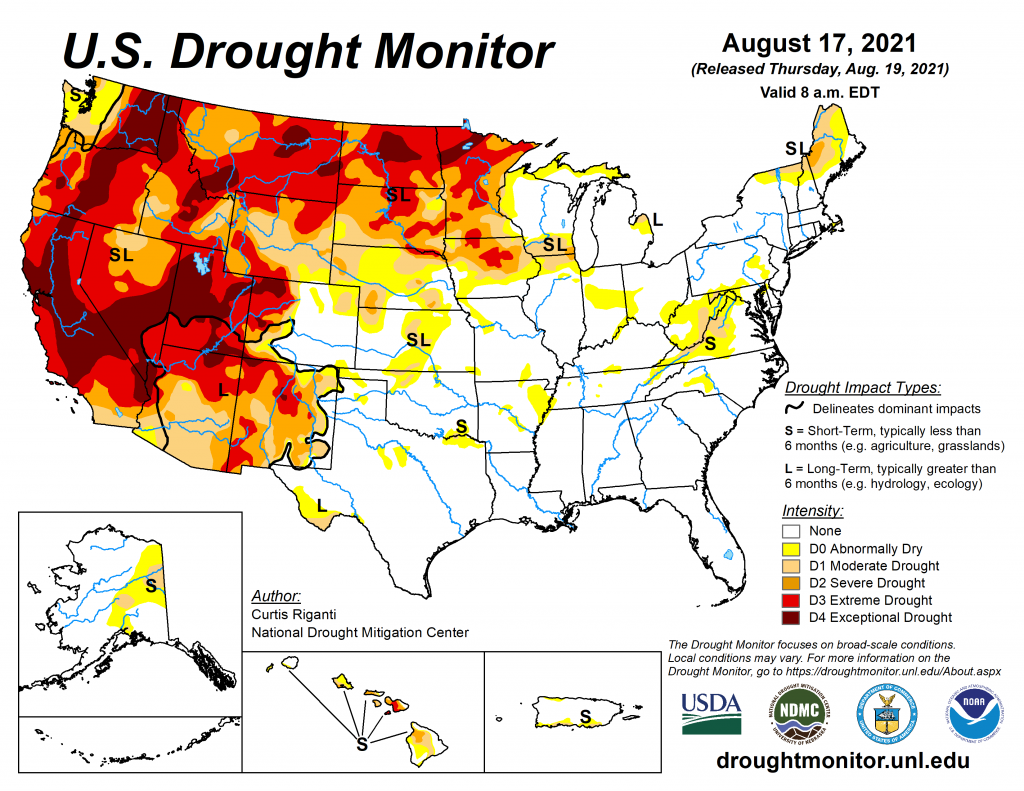Posted on August 25, 2021 by Richard M. Frank[1]
The American West is in the throes of a “megadrought”—one that’s plagued the region since 2000. Indeed, the Western U.S. has entered an era of water crisis that’s unprecedented in recorded American history. Due to climate change, that drought has been getting progressively worse: warmer winters lead to less precipitation, and hotter summers cause drier conditions, creating a vicious, downward cycle of heat and drought. Climate scientists warn that longer and more intense Western droughts are not an aberration—they’re the “new normal.”

The alarming effects of the West’s megadrought are multifaceted. Without sufficient rain and water, wildlife inevitably suffer, ecosystems are severely damaged, and the number and severity of wildfires triggered by torrid temperatures and dry vegetation will continue to plague Western states.
Megadrought profoundly affects people as well. With unprecedented drought conditions, the West’s agricultural sector is in crisis: due to the lack of available water, farmers and ranchers are fallowing fields, uprooting orchards and vines and culling herds. Severe drought also affects urban areas, with cities like Phoenix, Las Vegas and Los Angeles facing unprecedented water shortages and supply cutbacks.
Fortunately, there are a number of readily-available policy and legal reforms that, if adopted, could blunt the most severe effects of current Western drought conditions.
First and foremost, water conservation programs that create ways to use water more efficiently need to be greatly enhanced, promptly implemented, and mandated by water managers in both the agricultural and urban sectors.
Western agriculture consumes approximately 80% of all human water use. Currently existing technologies to improve crop irrigation practices would save huge amounts of water in the American West. For example, sophisticated drip irrigation systems can and should replace traditional, less efficient “flood irrigation” practices. Computerized systems that identify how much water is required for different crops and when that water is most efficiently applied could generate further, substantial water savings.
In urban areas, between 40-70% of household use of water is devoted to landscaping. Western residents and government officials need to recognize that maintaining expansive, thirsty lawns is a luxury that an arid, water-starved region can no longer afford. Water officials should mandate a prompt transition to drought-resistant landscaping that doesn’t require regular watering. And recycled rather than potable water should be mandated to irrigate urban parks, golf courses, etc.
Second, water markets that put a fluctuating price on water depending on demand allows buyers and sellers to trade water through both short-term leases and permanent sales of water rights. When there’s a shortage, water markets can incentivize water users to conserve and sell excess supply. Water markets can also facilitate efficient exchanges of water that take different priorities into account: for example, a farmer could choose to forgo watering low-value crops and instead sell water from her land to a municipality for domestic and commercial uses instead. Water markets are not as well-developed in the American West as in some other nations, but they can and should be more widely embraced. However, it’s critically important that Western water markets be fully transparent and administered by public agencies, rather than “commodified” by corporations and hedge fund managers. Water transfers should be encouraged when they’re in the public interest—not simply as a way to maximize private revenue.
Finally, in the U.S., water rights are allocated and administered at the state level. In many Western states (California being a prominent example), hidebound and antiquated water rights systems created in the 19th century still allocate water based simply on who obtained them first, rather than assessing how much water is actually needed and ensuring its distribution is equitable. Additionally, most of these water rights were granted by Western states decades or even centuries before environmental values and needs could be made part of the equation. As a result, Western water rights systems are not flexible and nimble enough to deal effectively with the protracted droughts and water shortages endemic to the 21st century. State legislatures can and should act to reform these outdated systems without delay. The unprecedented drought and resulting water shortages currently confronting the American West represent a clear and present danger to the region’s health, economy and environment. But necessary reforms, if timely and effectively implemented, can temper the worst impacts of the West’s unprecedented water crisis.
[1] Richard Frank is Professor of Environmental Practice and Director of the California Environmental Law & Policy Center at the University of California, Davis School of Law.
